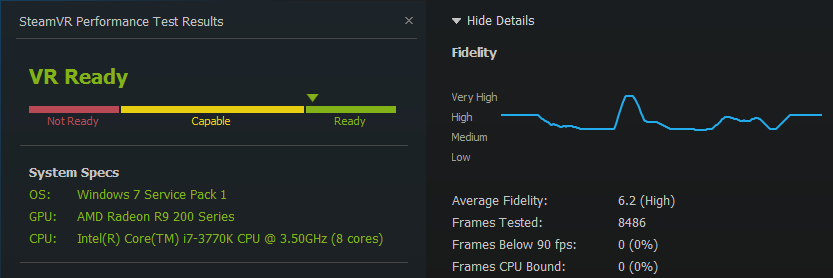I got the Vive Pre set up and running today.
After updating the Nvidia drivers, it was able to use Direct mode and then LFS ran well as expected, maintaining the required 90 fps.
Good news is the lighthouse is far quieter. The old one was very noisy and quite unbearable but the new one is not disturbing. It is an audible whirring with the volume something like a computer fan. I can even leave it running while I do something else.
The picture seems quite nice. I guess I'll do a comparison with the Rift DK2 at some point. Obviously as a "first generation" device, the resolution is still low when looking into the distance. But that doesn't really bother me. Actually it works quite well and I'd like to go and do some racing with it on.
I am interested in the camera, that supposedly allows you to see the world, temporarily, through the headset. That would be helpful to see the keyboard when online. Although there is only one camera so I expect the scale of things to look a bit funny. Trying to switch on the camera in the SteamVR software, it just told me nothing was working, but there was no explanation. Haven't looked further into this yet.
On the bad side, there was a lot of installing, waiting for drivers to install, error messages, switching off, switching on, updating firmware, more error messages, waiting, random success messages, more firmware, computer restart, etc... I have no idea why it's so hard. It seems to take hours. Anyway, after enough restarts and retries it eventually works (except for the camera, apparently). The SteamVR software is buggy and sometimes just crashes, sometimes the headset is detected then suddenly it claims the headset isn't there, then you can't exit the software because it is eternally "preparing to exit" or similar. Task manager is required at that point. After many attempts, I could run the room setup but that is quite buggy too. It's best to avoid running SteamVR at all. LFS, though OpenVR, can switch on the headset. But the settings are only available through SteamVR. Once I managed to run SteamVR long enough to be able to switch off the awful "chaperone" which is an annoying grid that just makes a mess of the picture. The idea is to stop you walking in to a wall, and I'm sure that's useful for room scale experiences but is totally pointless when you are seated in a racing game! There is no easy way to switch off the chaperone but eventually I set it to "developer mode" and now, as long as SteamVR is not running, I can run LFS and not see the chaperone. One other thing I don't like is it's quite hard to allow the speakers to work. By default, the Vive takes over the sound and it wants you to wear headphones. There is no option in SteamVR to switch off this behaviour and it must be done in the Windows audio settings which seem very confusing. Anyway after randomly switching things on and off for 20 minutes or so, I could hear sound again! At least that setting does stick!
The unit looks much nicer, smaller, and is a lot shorter from front to back. I found it more comfortable than the old Vive. The cardboard packaging was of a high quality and it seemed physically like a production unit instead of a prototype. Even all the plugs were UK style so no adapter was required.
Overall I'm quite pleased with it, because it is usable and seems to provides a good VR experience. I will look into the camera, to find out how it can be enabled and if this can be controlled by the software. Ideally I'd like to assign camera on/off to a wheel button.





